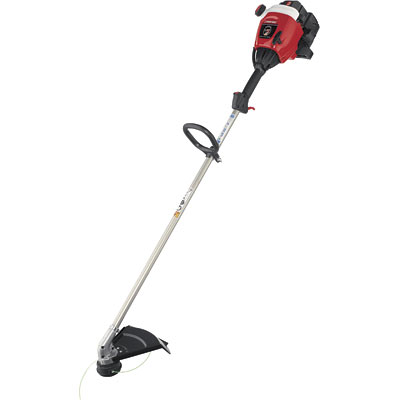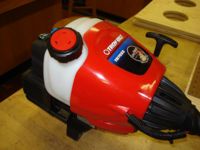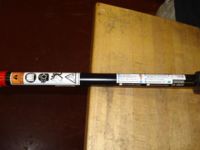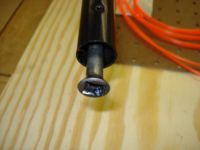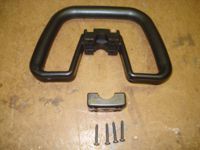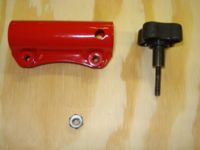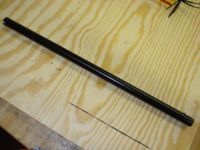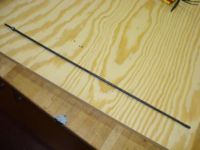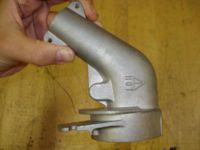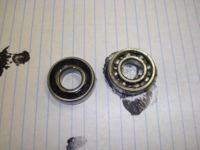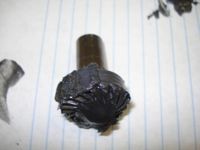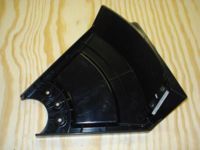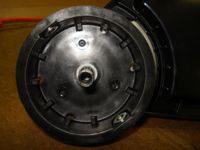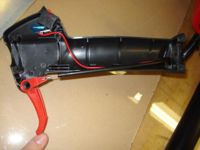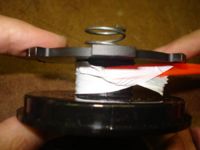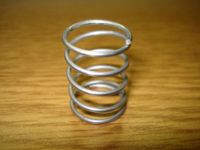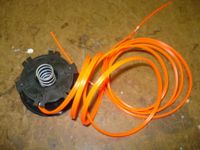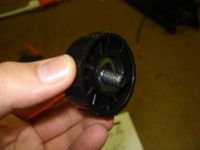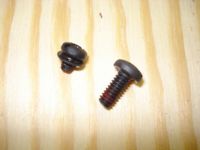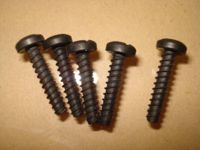Weed whacker
From DDL Wiki
(→Executive Summary) |
(→References) |
||
| Line 329: | Line 329: | ||
== References == | == References == | ||
| + | |||
| + | "Mechanics of Materials" Author: Riley, Willliam F. | ||
| + | "Engineering Design, 4th edition" Author: Dieter, G and L.Schmidt | ||
Revision as of 14:59, 24 September 2008
Contents |
Executive Summary
For our Engineering Design II project, we have decided to dissect and improve the 2-Cycle Straight Shaft Trimmer made by Troy-Bilt. We intend to improve its user functionality, the manufacturing process, and also reduce the impact the life of this product has on the environment. We will disassemble this trimmer in order to take a close look at all of its parts. This will help us to have a full understanding of how this machine really works. By performing Design for Manufacture and Assembly (DFMA), Failure Mode Evaluation and Analysis (FMEA), and Design for Environment (DFE), we will carefully document our findings, decisions, and conclusions in order for our client to clearly see the merits in the product we have reinvented.
Our analysis of the Troy-Bilt trimmer has uncovered several problems and room for improvement. Potential changes in the screws, shafts, axles, and plastic parts have been proposed. Also, an EIO-LCA analysis has shown that the engine emits
Our report will show a list of parts and their respective weights, material, and method of production.
A structural analysis has shown that this product is rigid and reliable. It takes so much force to break this product that you would most likely have to do so on purpose. As a result, we will concentrate our efforts more towards
Stakeholders
There are several stakeholders that will be affected by our changes to this product. Each stakeholder has both similar and unique needs in relation to this product, and they include:
- Users - includes the common lawn owners and also professional gardeners
- Aesthetics
- Cost
- Efficiency
- Reliability
- Ease of use
- Safety
- Portability
- Aesthetics
In the end both the common lawn owner and the professional gardeners have very similar needs in terms of using the weed whacker. However, their priorities within this list can vary.
Professional Gardener - Since a professional gardener will be using this product on a daily basis as well as for possibly several hours per day, they will prioritize the weight of the product and its efficiency more so than the common lawn owner. This product can start to feel really heavy rather quickly, especially if the weight is not distributed in a comfortable fashion. Also, it will be an important concern to them how long they can trim on a single full tank of gas. These concerns may outweigh the importance of safety and especially aesthetics.
Common Lawn Owner - Aesthetics will inevitably be important for the common customer. It must look safe, reliable, and easy to use in addition to actually being so. Safety is an obvious issue for the customer, considering the possibility of them using the product improperly or simply experiencing some sort of accident. Also like the professional, they will appreciate a lighter product, and although it will not be as important to them, they would want their trimmer to last longer on a single tank of gas.
- The manufacturer
- Material cost
- Manufacturing cost
- Ease of assembly
- Customer needs
- Material cost
The needs of the manufacturer are quite clear. They will want to make as many of these products with the least amount of time, cost, effort, and also impact to the environment. These needs will be discussed in length in the DFMA section. However, it is important to remember that this product needs to be sold in a competitive market, and hence the customer's needs will be highly prioritized.
- Raw material suppliers
- Material Cost
- Success of product
- Material Cost
There isn't much concern to the raw material suppliers other than selling as much material as they can. A combination of selling more materials per product for more products will earn them more profits and satisfaction.
- Retailers
- Same needs as customer
- Customer satisfaction
- Same needs as customer
Since the retailers must sell these products to the customer, they want their product to satisfy all the needs of their customer. In fact, they want their products to exceed what the customer wants. For example, they do not want the customer to return their purchased item for unforseen problems or unforeseen needs that were not met. In addition, they want satisfied customers to come back to their store to buy more products from them.
Product Usage
Usage of a weed whacker is very straight forward. For situations and areas where a lawnmower would be difficult to use, the hand-held weed whacker becomes a tool of choice. The convenience of this gardening tool comes from its ability to quickly cut vegetation in hard to reach places without damaging structures that may surround it.
In order to power on the weed whacker, first make sure there is sufficient gas in the tank. Click the on/off switch to on. Intructions on how to start the motor are included on a sticker on the straight shaft, and are as follows:
For a cold engine:
1. Press bulb 10 times.
2. Move blue choke lever to "1".
3. Squeeze trigger and pull rope 5 times.
4. Move blue choke lever to "2".
5. Squeeze trigger and pull rope till engine starts. If it doesn't start, repeat steps 1-5.
6. Let engine run 15-30 seconds.
7. Move blue choke lever to "3".
For a warm engine:
1. Move blue choke lever to "2".
2. Squeeze trigger and pull rope till engine starts.
3. Move blue choke lever to "3".
Once the engine is running, it is a simple matter of pointing the spinning wire towards the vegetation you wish to cut. If you wish to lengthen the wire, tap the bottom of the weed whacker to the ground, and a pre-measured length of wire will be added on. To stop the motor, simply press and hold the off button.
System Functions
After starting the engine, the weed whacker is controlled by a single trigger. This trigger controls the fuel feed to the engine, allowing the user to change the rotational speeds of the two-cycle engine.
The power of the engine is transferred to an axle contained in the upper shaft. The axle is held in the center of the shaft using spacers. The end of the upper axle is shaped to slip over the end of the lower axle. The two axles connect using a square cross section that allows the power from the upper axle to completely transfer to the lower axle. To compensate for the possibility of misalignment, the two axles are made to be flexible.
The lower shaft is held to the upper shaft using the shaft clamp. This shaft clamp is screwed directly into the upper shaft, and holds the lower shaft by the metal nub.
At the bottom of the lower shaft, there is a large metal housing. Within this housing, there are four bearings and a set of bevel gears. The lower axle attaches to the bevel gear in the same manner as the two axles. Two bearings are placed on each end to keep the bevel gears in contact. With the gears, the power transfers completely from the lower axle to the weed whacker head.
Attached to the weed whacker head, is a reel that contains a long piece of wire. The wire is fed through two small holes exposing approximately 5 inches of wire. While the head is rotating, the wires are used to cut weeds. Due to the high speeds of the wire, there is no need for sharp edges, as the impact from the wire alone is enough to cut through plants.
Components
**Note: Some assemblies and parts were not disassembled in order to avoid destroying the parts.
Failure Mode Effects Analysis (FMEA)
Failure Mode and Effects Analysis (FMEA) is a crucial tool in determining if a particular component in a system will fail (in terms of the customer's requirements). By looking at each piece, we can rate the severity of a failure (S), the probability that it will occur (P), and the likelihood that the customer would detect the failure (D). The severity of failure is rated between 1-10, 1 being the effect is not noticed by the consumer, while 10 is hazardous. Probability of occurence is also rated from 1-10, 1 being extremely remote while 10 has an extremely high chance of occurring. Finally, detection is rated from 1-10 with 1 being almost certain to detect and 10 being no chance of detection whatsoever. With these three factors, we can multiply them together to achieve a total risk priority number (RPN) which can range from 1-1000 (1000 being the greatest risk). Below is a table outlining each part.
| Item and Function | Failure Mode | Effects of Failure | S | Causes of Failure | O | Design Controls | D | RPN | Recommended Actions | Responsibility and Deadline | Actions Taken | S | O | D | RPN
|
|---|---|---|---|---|---|---|---|---|---|---|---|---|---|---|---|
| Engine | Fouled spark plug | Engine won't start | 8 | Spark plug is dirty or broken | 3 | Fatigue testing | 1 | 24 | Approximate the life-span of the spark plug | Engine manufacturer | - | ||||
| Carburetor | Engine won't idle | 7 | carburetor not adjusted properly | 3 | Fatigue testing | 1 | 21 | Add more lubricant | Engine Manufacturer | - |
| ||||
| Bevel Gears | Slip | Wire doesn't rotate | 7 | gears aren't properly aligned | 2 | Unalign gears and turn on | 6 | 84 | Check how much tolerance the shafts give the rod and gears | - | |||||
| Jam | Wire doesn't rotate | 8 | Not enough lubricant | 2 | Remove lubricant and turn on | 5 | 80 | Add more lubricant | - |
| |||||
| Axle | Fracture | Wire doesn't rotate | 7 | Fatigue | 1 | Fatigue testing | 4 | 28 | Not likely, so ignore | - | |||||
| Wear down | Lower shaft axle won't spin at full potential | 6 | Lower shaft axle doesn't securely mate with upper shaft axle | 2 | Fatigue testing | 5 | 60 | Not likely, so ignore | - | ||||||
| Shaft Clamp | Dent | Shaft wont fit into clamp | 8 | Something heavy dropped onto clamp | 1 | Stress testing | 1 | 8 | Not likely, so ignore | - |
| ||||
| Handle | Slip | Reduced control when holding | 6 | Screws loosen over time | 7 | Fatigue testing | 2 | 84 | Look into improved handle design | Design Engineer | - | ||||
| Fracture | No working handle for off hand | 6 | Item is dropped onto handle | 4 | Impact stress testing | 3 | 72 | Look into improved handle design | Design Engineer | - | |||||
| Fatigue | Handle deforms over time, less convenience for user | 4 | Repeated adjustment of handle, use over time | 6 | Fatigue Testing | 3 | 72 | Look into improved handle design | Design Engineer | - | |||||
| Head | Tangled Wire | Wire inside head jams up | 8 | Improper wire loading | 3 | Field Testing | 2 | 48 | Ensure easy/intuitive wire replacement process for user | Process Engineer | - | ||||
| Fracture | Cracks or openings in head, inhibiting wire feed or even proper head fit | 8 | Slamming head into rough object while it's spinning | 2 | Field Impact Testing | 2 | 32 | Not likely, so ignore | - | ||||||
| Bearing | Jam | Bearing has friction, slows axle down | 7 | Left in rain, water can reach bearing and rust | 2 | Bearing Testing | 2 | 28 | Ensure bearings are guarded from elements | Assembly | - | ||||
| Shield | Fracture | Can't effectively guard user from debris or wires | 5 | Weed Whacker is dropped, shield takes impact | 7 | Stress Testing | 2 | 70 | Design more reliable shield | Design Engineer | - | ||||
| Grass accumulation | Grass build up under shield | 2 | Use over time without cleaning | 9 | Field Testing | 1 | 18 | Design more reliable shield | Design Engineer | - | |||||
| Trigger | Fracture | Convenient engine control diminished | 5 | Sharp force applied to trigger in wrong direction | 1 | Stress Testing | 2 | 10 | Not likely, so ignore | - |
Design for Manufacture and Assembly (DFMA)
The weed whacker is a relatively simple product with simple parts. Nevertheless, we have noticed that many of the parts can be changed to make manufacturing and assembly easier, and they include:
- Screws
- Five types of screws
- Only one tool required (same TORX wrench can be used for all screws)
- Shaft
- Same length & material
- Same spacers for the axle
- Axle
- Both are different
- Plastic parts
- Unnecessary shapes
Possible Improvements
Screws - Using five different types of screws is unnecessary in this design. It could easily be reduced down to two.
Shafts - The two shafts that connect to each other are different from one another when they do not have to be. By making them identical, they can share the same manufacturing process.
Axle - The axles can also be made the same to reduce the complexity of assembly.
Plastic parts - Modifying the design of the injection molded plastic parts, including the handle and the shield, could easily save materials. Both the handle and shield seem to be more complicated than they have to be. The shield for example has unnecessary ridges, and the handle is much larger than needed. Perhaps the additional complexity was added for aesthetics, but they do not have a purpose. We assume the handle was designed as it was to be gripped from the sides as well, however, using one hand to hold it from the side in this way would put a significant amount of strain on that hand in order to keep the weed whacker upright. The best place to hold it is from the top keeping the center of mass underneath the user's hands. Therefore, the handle only needs to be horizontal or perhaps triangularly shaped to maintain both user comfort as well as aesthetic appeal.
Design for Environment (DFE)
The Economic Input-Output Life Cycle Assessment (EIO-LCA) website, www.eiolca.net, contains data on the most common contributors to greenhouse gases, toxic releases, and energy usage from industries and sections of those industries. Using this tool, we can get a ball park figure of the environmental impact of the life cycle of our weed whacker.
Table 1: Economic Life Cycle Assessment

Table 2: Environmental Life Cycle Assessment
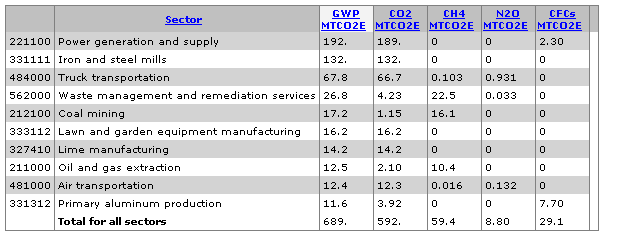
Usage
Since the mechanics of how a weed whacker works are quite simple, there is little that can be done to reduce waste from the usage of this product. The mechanics that go into a weed whacker are frankly quite simple. From the explanation in the functionality section, it can be seen that little can be done to improve the power transfer from the engine to the rotating wires. However, studying the engine itself shows room for possible improvement.
This particular weed whacker design uses a 2-cycle engine as its power source. This method is harmful to the environment, as it allows unused gasoline and oil to escape as exhaust. Not only is it emitting a lot of carbon dioxide as well as some hydrocarbons, it is also releasing unburnt gasoline. The gasoline vapors react with the sunlight creating even more carbon dioxide, nitrous oxides, and more volatile organic compounds. The inefficiency of the 2-cycle engine has a very large impact on green house gases and the environment.
Mechanical Calculation
In order to increase the ease of usage of the wheed whackers, parts were assembled in a way that it creates less moments. For example, with engine weighing 4.08233 kg and stick weighning 1.202kg, one is 106 cm and other is 50.8 cm away from the handle, using the formula M = LF, moments of only -2.42011N-M was created.
Another thing that should be taken account is that wheed whacker is build with huge magnitude of safety. Using the formula stress = F/A and A = area of the tube along the diameter, we found that the stress that is applied was 10209 Pa. And since the material of the wheedwhacker is steel, it has yield strength of 250 MPA. Which is far above the maximum stress on the wheed whacker. Even if we drop it and apply the force of 100 N to the pole, the calculation still did show that the weed whacker could withstand it.
Process
Timothy Andersen
Wesley Chu
Koji Ito
Michael Menchaca
References
"Mechanics of Materials" Author: Riley, Willliam F. "Engineering Design, 4th edition" Author: Dieter, G and L.Schmidt
